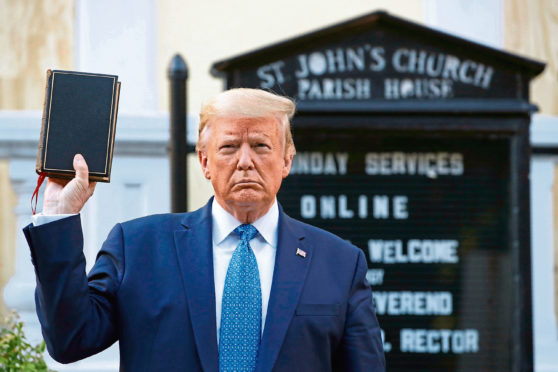Presidents and politicians using the Bible or Christian symbolism for political ends is certainly nothing new.
Some, as President Trump did recently, posed with Bible in hand, but far more common is the selective quoting, misquoting, or downright twisting of Bible verses to advance their political agendas.
After nights of rioting, violence and death across American cities, even right outside the White House, the president punctuated his inflammatory speech by walking from the Rose Garden to a historically important church that was nearly burned down the night before.
He then posed with a Bible in his hand with the church sign as his backdrop.
Trump was condemned widely, and justifiably so, but not just by those who take the Bible seriously.
In fact, among the loudest voices were religious leaders who themselves use the Bible as a prop.
For example, on a national TV show, Bishop Mariann Budde, Episcopal Bishop of Washington DC, accused Trump of abusing “the spiritual tools and symbols of our traditions and of our sacred space”.
To reduce the Bible to a prop, a mere “spiritual tool” or a “symbol”, however well intentioned, is to miss the Bible’s real power, a truth the world so desperately needs right now.
After all, it is the explanatory capacity of holy scripture, its ability to describe the contours of reality and the human condition so accurately, that makes it so valuable, not just to Christians but to society at large, especially in dangerously confusing times like these.
Rather than using it to advance an agenda or score points with a religious base, it would have been far more valuable and helpful if the president had opened it and read to the nation its words of comfort and conviction, and especially its call to repentance.
Sociologist and author Rodney Stark argues that Christians were the very first people in history to even imagine that slavery was not a normal condition of human society, as was universally assumed throughout history.
While there were those, like the Jewish Essenes, who did not like slavery, “only in Christianity,” Stark argues, “did the idea develop that slavery was sinful and must be abolished”.
Why did this idea develop in Christianity and not anywhere else? The answer lies in the teaching and eternal truths of the Bible.
Though Jesus’ first followers did not forbid slavery, they did in their New Testament writings, especially the Apostle Paul, unlock implications of our identity as image bearers of God and new creations in Christ, including the notion of universal human dignity.
Resulting in long-standing social barriers between Jew and Gentile, slave and free, male and female, being challenged and eventually torn down.
Centuries later, British Christians such as William Wilberforce would launch years of campaigning to end the scourge of slavery.
Other Christians, informed by what was written in the Bible, would lead the movement for civil rights in the USA with arguments constructed from the Christian framework of reality found only in holy scripture.
None of this is to say that Christians always got issues of race or slavery right. They certainly did not.
But, as even atheist historians and philosophers have acknowledged, the world owes a debt to the Bible for the very notions of human value, human rights, and human dignity.
A recent article in Christianity Today magazine suggested that not only does the Bible teach us in the book of James (and other places) that favouritism and racism are wrong, and that a system that treats people of colour with different outcomes is, well, sinful, but also that “stealing, looting, and violence are (also) clearly addressed and condemned in the Bible”.
And further, it points us to forgiveness and grace, required resources if we hope to be reconciled to God and to each other.
In other words, written plainly in the pages of the Bible the president held aloft for the camera a few days ago, is exactly what we need right now, including the keys to recapturing civic virtue, pursuing reconciliation, and restoring civil society.
The better choice, especially in a society guilty of either ignoring the Bible or twisting it out of context, would be to heed the exhortation contained in this prayer written by Anglican theologian Thomas Cranmer a few centuries ago:
“Blessed Lord, who caused all holy Scriptures to be written for our learning. Grant us so to hear them, read, mark, learn, and inwardly digest them, that we may embrace and ever hold fast the blessed hope of everlasting life, which you have given us in our Saviour Jesus Christ; who lives and reigns with you and the Holy Spirit, one God, for ever and ever. Amen.”
In this moment of worldwide crisis, rather than fighting among ourselves over interpretations of the Bible, we’d be far better off reading, hearing, and applying what it has to say.
John Young is a former soldier, Salvation Army officer and Grampian regional councillor for Bridge of Don in Aberdeen

